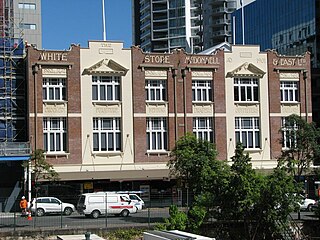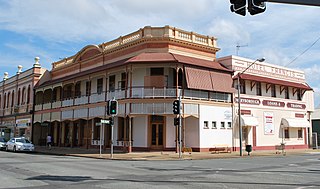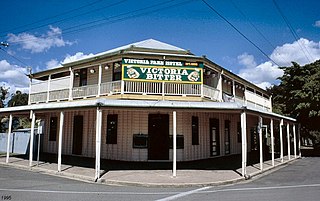
South Brisbane railway station is a heritage-listed railway station at 133 Grey Street, South Brisbane, City of Brisbane, Queensland, Australia. It is one of two stations serving the South Brisbane area, the other being South Bank. It was built from 1891 to 1918, making it the second oldest railway station in central Brisbane. It is also known as Cultural Centre Station, Melbourne Street Station, and South Brisbane (Interstate) Station. It was added to the Queensland Heritage Register on 21 October 1992.

The Orient Hotel is a heritage-listed hotel at 560 Queen Street, Brisbane CBD, City of Brisbane, Queensland, Australia, on the corner of Ann Street. It was originally built as the Excelsior Hotel in 1875 and extended in 1884, both of which were designed by Brisbane architect Richard Gailey. It was added to the Queensland Heritage Register on 23 April 1999.

Exchange Hotel is a heritage-listed hotel at 134-138 Patrick Street, Laidley, Lockyer Valley Region, Queensland, Australia. It was designed by Eaton & Bates and built in 1902. It was added to the Queensland Heritage Register on 21 October 1992.

Tattersalls Club is a heritage-listed club house at 206 Edward Street, Brisbane City, Queensland, Australia. It was designed by Hall and Prentice and built from 1925 to 1949. It was added to the Queensland Heritage Register on 21 October 1992.

Wickham Hotel is a heritage-listed hotel at 308 Wickham Street, Fortitude Valley, City of Brisbane, Queensland, Australia. Originally trading as the Oriental, it was designed by Richard Gailey and built in 1885 by Cussack & O'Keefe. It was added to the Queensland Heritage Register on 21 October 1992.

Prince Consort Hotel is a heritage-listed hotel at 230 Wickham Street, Fortitude Valley, City of Brisbane, Queensland, Australia. It was designed by Richard Gailey and built from 1887 to 1888 with later extensions. It was added to the Queensland Heritage Register on 21 October 1992. In 2014, it is trading as the Elephant Hotel.

Coronation Hotel is a heritage-listed hotel at 46 Montague Road, South Brisbane, Queensland, Australia. It was designed by Francis Drummond Greville Stanley and built in 1891. It is also known as Montague Hotel. It was added to the Queensland Heritage Register on 30 April 1993.

Norman Hotel is a heritage-listed hotel at 102 Ipswich Road, Woolloongabba, City of Brisbane, Queensland, Australia. It was designed by John Beauchamp Nicholson and built from 1889 to 1890. It was added to the Queensland Heritage Register on 12 July 2005.

Royal George Hotel and Ruddle's Building is a heritage-listed hotel at 323–335 Brunswick Street, Fortitude Valley, City of Brisbane, Queensland, Australia. It was built from c. 1850 to the 1960s. It is also known as Bush & Commercial Inn, Commercial Inn, Freemasons Arms, and Ruddle's Corner. It was added to the Queensland Heritage Register on 3 August 1998.

Harris Terrace is a heritage-listed terrace house at 68 George Street, Brisbane City, City of Brisbane, Queensland, Australia. It was designed by J & G Cowlishaw and built from c. 1866 to c. 1867 by Mr Clarke. It is also known as Harris Court. It was added to the Queensland Heritage Register on 21 October 1992.

Treasury Hotel is a heritage-listed hotel at 175 George Street, Brisbane City, City of Brisbane, Queensland, Australia. It was designed by John Hall & Son and built from 1887 to 1888 by Abraham James. It was added to the Queensland Heritage Register on 4 November 1993.

McDonnell & East Ltd Building is a heritage-listed former department store at 414 George Street, Brisbane City, City of Brisbane, Queensland, Australia. It was designed by Thomas Ramsay Hall and built from 1912 to 1928 by Andrew Gillespie. It was added to the Queensland Heritage Register on 10 December 1997.

Marburg Hotel is a heritage-listed hotel at Edmond Street, Marburg, City of Ipswich, Queensland, Australia. It was built from c. 1881 to c. 1890. It was added to the Queensland Heritage Register on 21 October 1992.

William Johnston's Shops are a heritage-listed row of three shops at 93 Brisbane Street, Ipswich, City of Ipswich, Queensland, Australia. They were built from 1877 to 1880s. It was added to the Queensland Heritage Register on 21 October 1992.

Hotel Francis is a heritage-listed former hotel at 310 Kent Street, Maryborough, Fraser Coast Region, Queensland, Australia. It was built in 1878. It is also known as Metropolitan Hotel (1878–1935). It was added to the Queensland Heritage Register on 21 October 1992.

The Heritage Hotel is a heritage-listed hotel at 230 Quay Street, Rockhampton, Rockhampton Region, Queensland, Australia. It was designed by John William Wilson and built in 1898 by John Kerslake Evans. It is also known as the Old Colonial Hotel and the Commercial Hotel. It was added to the Queensland Heritage Register on 21 October 1992.

Victoria Park Hotel was a heritage-listed hotel at 266 Boundary Street, South Townsville, City of Townsville, Queensland, Australia. It was designed by Tunbridge & Tunbridge and built from 1895 to 1896 by Jeremiah Dempsey. It was added to the Queensland Heritage Register on 21 October 1992. It was completely destroyed by fire on 8 June 2018.

Hides Hotel is a heritage-listed hotel at 87 Lake Street, Cairns City, Cairns, Cairns Region, Queensland, Australia. It was designed by Sydenham Stanley Oxenham and built in 1928 by Michael Thomas Garvey. It is also known as Hides Cairns Hotel. It was added to the Queensland Heritage Register on 21 October 1992.

The 1873 Roma Street railway station building is a heritage-listed railway station building at Roma Street railway station, 159 Roma Street, Brisbane central business district, City of Brisbane, Queensland, Australia. It was designed by Francis Drummond Greville Stanley and built from 1873 to 1875 by John Petrie. It is also known as Brisbane Passenger Station, Brisbane Terminal Station, and Brisbane Terminus. It was added to the Queensland Heritage Register on 24 March 2000.

Filigree architecture is a modern term given to a phase in the history of Australian architecture. The phase was an embellishment of the "Australian verandah tradition", where the verandah evolved from its functional usages in the Old Colonial period to become highly ornamental. The filigree style was a vernacular tradition of buildings possessing prominent verandahs that screened the facade, cloaking the building in an ornamental veil that obscured the exterior walls, thus becoming the main visual element. The name "filigree" refers to the intricate texture of this verandah screen, which was often perforated to let air and light pass through, creating dazzling displays of shadows.
























